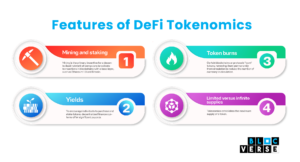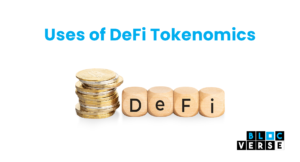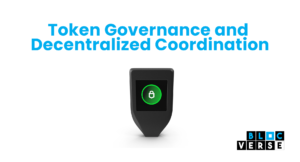INTRODUCTION
You can tell a crypto project that would do well by its tokenomics, but why is that?
Tokenomics is a compound word from ‘token’ and ‘economics,’ which refers to a token’s utility, scalability, and value in the crypto world.
In a world with tons of crypto projects with no guarantee of longevity, investors and interested parties rely on a project’s tokenomics as a deciding factor for participation. Tokenomics serves as a significant component of scrutinizing a cryptocurrency project.
Therefore, it is safe to say that well-put-out tokenomics is critical to attracting investors to such projects and guaranteeing their success.
This article explains Defi Tokenomics, its importance, and how it works.
Here’s an outline of what we covered in this article:
- What Is DeFi Tokenomics?
- Features of DeFi Tokenomics?
- Tokenomics Analysis: How Does Tokenomics Work?
- Importance of DeFi Tokenomics
- Token Governance and Decentralized Coordination
- Example of Tokenomics
- Conclusion
WHAT IS DEFI TOKENOMICS?
Tokenomics is indeed the science of token economics. It includes, but is not limited to, a token’s generation and distribution, supply and demand, incentive systems, and burn schedules.
Tokenomics must be well-designed for crypto initiatives. Investors and stakeholders must evaluate the tokenomics of a project.
Blockchain projects establish tokenomics to incentivize or prohibit various user behaviors and set rules for their tokens. This is comparable to how a central bank issues money and executes monetary policies to encourage or discourage consumption, lending, and money circulation. Token refers to currencies and tokens in this context. In contrast to fiat currencies, tokenomics rules are enforced by code, visible, predictable, and impossible to alter.
What Is A Crypto Token?
Two fundamental types of tokens fuel the world of decentralized finance (DeFi):
(1) Tokens that are fungible, such as bitcoin (BTC), ether (ETH), Matic (MATIC), and other cryptocurrencies.
(2) Non-fungible Tokens (NFTs), like digital collectibles and other special digital assets.
Manually exchanging these tokens is possible. However, DeFi transactions can be carried out using smart contracts (contracts that automatically execute when their terms and conditions are met).
All DeFi transactions are stored on a distributed ledger in every instance (distributed ledger).
In the context of cryptocurrency, it is a digital currency created by crypto projects that operate on an existing blockchain. In the same way that regular cash has value and can be traded for other things, so do crypto tokens. Understanding how token and conventional economics vary is essential to grasp this concept fully. Governments throughout history have always been able to “print” more money out of thin air.
However, the cost of fighting a war or managing a drought can be very high. In these cases, administrations sometimes resort to minting new currency as a quicker and easier solution than trying to increase tax collection. In the long run, the value of currency declines as more of it is printed. On the other hand, token issuance schedules in crypto projects are fixed ahead of time and generated by an algorithm. There is knowledge of how many coins will be in circulation at any time.
In addition, the coin distribution to the various stakeholders is planned ahead of time. Therefore, changing the distribution and issue timetable is possible, although doing so is cumbersome.
Features Of DeFi Tokenomics

The economic structure of a cryptocurrency determines the incentives for investors to purchase and keep a particular coin or token. Similar to how each fiat currency has its monetary policy, each cryptocurrency has its own.
Tokenomics determines two aspects of a crypto economy: the incentives that decide the method of token distribution and the utility of the tokens, which affects their demand. The relationship between supply and demand significantly impacts pricing, and projects with the proper incentives can experience a significant increase in value. The following are the primary variables that developers can alter to effect tokenomics:
Mining and staking
Mining is the primary incentive for a decentralized network of computers to validate transactions in blockchains with a base layer, such as Ethereum 1.0 and Bitcoin. Here, individuals who spend their computational power discovering new blocks, filling them with data, and adding them to the blockchain are rewarded with new coins. Staking compensates people who perform a similar function by locking away several coins in a smart contract — this is how blockchains like Tezos function, and it’s the paradigm that Ethereum’s 2.0 upgrade is leaning toward.
Yields
To encourage individuals to purchase and stake tokens, decentralized finance systems offer significant payouts. Tokens are staked in liquidity pools, which are enormous pools of coins that fuel decentralized exchanges and lending systems. These returns are distributed as brand-new tokens.
Token burns
Certain blockchains or protocols “burn” tokens, removing them permanently from circulation to reduce the number of currency in circulation. According to supply and demand principles, lowering a token’s quantity should boost its price as the remaining tickets become scarcer. In August 2021, Ethereum began burning a portion of transaction fees rather than distributing them to miners.
Limited versus infinite supplies
Tokenomics establishes the maximum supply of a token. For instance, the tokenomics of Bitcoin stipulates that no more than 21 million coins can ever be created, with the final coin entering circulation around 2140. Ethereum has no maximum limit, while its annual issuance is regulated. NFT (non-fungible token) projects take scarcity to an extreme; such collectors may mint a single NFT for a work of art.
Token distributions and vesting periods
Some crypto initiatives account for the allocation of tokens in great detail. Typically, a limited amount of tokens are kept for venture investors or developers, but they can only sell them after a specific period.
This has an effect on the number of coins in circulation over time. Ideally, a project’s team will have devised a token distribution scheme that minimizes the impact on the token’s circulating supply and price.
TOKENOMICS ANALYSIS: HOW DOES TOKENOMICS WORK?

Tokenomics establishes the economy of a cryptocurrency project. This is achieved through incentivizing token holders and determining the tokens’ utility, which is a primary driver of their demand.
Economics is fundamentally about understanding the supply and demand of a currency. These two variables provide insight into the desirability of specific money. The same theory applies to tokenomics, providing a clear understanding of the supply and demand for a given token.
Among the factors used by developers to alter various aspects of tokenomics are the following:
Tokenomics and Supply
Considering only the supply, we must assess whether the value of a token will increase in real terms or be inflated away. According to economic theory, a token’s value will increase if fewer tokens are circulated. The term for this occurrence is deflation. In contrast, the value will fall if the total quantity of tokens increases. This describes inflation.
When analyzing the supply side, examining variables such as utility or the ability to generate revenue for its holders is unnecessary. The only condition is the supply’s fluctuation over time. During the release process, you evaluate the number of tokens currently in existence and the number algorithmically determined to be mined or distributed in the future.
Tokenomics and Demand
Only the demand side does not generate value. Instead, it is demand that determines a token’s value.
Let’s comprehend this phenomenon.
A fixed supply is not necessarily transformed into value. People must believe that the item has worth it now and will be in the future. Examining the return on investment (ROI), game theory, and memes will help you assess whether a token will be in demand.
Return on investment (ROI)
The Return on Investment (ROI) is the amount of money holding a token will bring in. One way an Avalanche (AVAX) holder can help keep the network safe while also increasing their holdings is by staking.
Stakeholders in specific protocols are entitled to a cut of the protocol’s earnings. For instance, SushiSwap (SUSHI) holders are entitled to the protocol’s profits.
Unless the token offers some return on investment, no one will want to keep it in their possession. However, if you find that other people have faith in the token’s value preservation abilities, you might be persuaded to invest in it.
Game Theory
Game theory is a fundamental mechanism underlying all technologies. It is the systematic study of how and why individuals make decisions. The game theory employs mathematical models of conflict and cooperation to comprehend decision-maker behavior. Applied to the crypto sector, it enables developers to evaluate the stakeholders’ decision-making process in an interactive setting.
Elements of the tokenomics architecture serve to increase token demand. For example, in tokenomics, lockups have proven to be a practical game theory. The protocol incentivizes token holders to lock their tokens in a smart contract in exchange for more significant incentives.
To receive a portion of the revenue on the Curve protocol, you must lock your Curve Protocol (CRV) tokens. Increase your earnings by closing the tokens for a more extended period. With significant incentives to stake CRV for longer, there are a few reasons for risking participants to release their tokens.
The community’s energy levels
Community fervor provides insight into the conviction of those who have placed money or emotions on the token.
One can assess their vigor on Discord, Twitter, and other social media platforms and determine the duration of people’s involvement in the community. It is also essential to ascertain if they are willing to incorporate the token into their identity.
Furthermore, community energy levels are crucial to the token’s future demand. Dogecoin is a prime example of how simple belief can propel a token forward (DOGE). Due to its cult-like popularity, a meme token has reached the top tier of crypto tokens.
USES OF DEFI TOKENOMICS

Ownership
A token can be used to indicate, correct or give access. In other words, a token can allow you to vote in a decentralized autonomous organization (DAO).
Infrastructure
DeFi projects contain infrastructure. Utility tokens are used to compensate token miners or for other internal reasons. Ethereum gas fees (the price ETH miners want) are a prime example.
Internal and External Value Exchange – Tokens are used to exchange the value created by a DeFi project.
Sharing of Benefits
Tokens are essential for the equal distribution of increased value. Essentially, they are the primary mechanism that allows token owners to share in the upside.
TOKEN GOVERNANCE AND DECENTRALIZED COORDINATION

The importance of governance in modern token economies cannot be overstated. Many tokens serve as so-called governance tokens, allowing their holders to vote on essential project matters.
This is done due to decentralization, so token holders may decide how the platform is managed. This approach prevents the management of these tokens by a small group of engineers. In this way, governance tokens might be compared to shares in a publicly traded corporation. Defi platforms are run by Decentralized Autonomous Organizations (DAOs), essentially token-based governance systems.
For any issue, holders have a vote: Uniswap’s DAO, for example, is currently debating whether or not to bring Uniswap V3 on Polygon’s proof-of-stake chain and Gnosis Chain. The tokenomics of a project are critical, and just as a careless CEO can bring a company to its knees, so too can poor governance decisions kill off the best DeFi enterprises. If all else fails, a new tokenomic timetable can be “hard forked” by copying a cryptocurrency’s coding. You can also make a few non-backward compatible changes and transfer existing cryptocurrencies and validators onto the new network.
Tokenomics Example
The Near Protocol (NEAR) technology behind Near Protocol offers various applications, including protecting the protocol itself. It also serves as a unit of account and medium of exchange for internal resources, external applications, and more.
There will never be more than one billion NEAR tokens in circulation. The protocol issues a predetermined percentage of tokens (about 5% per year).
90% of tokens are distributed as compensation to validators that maintain the network’s integrity by protecting its use for financial transactions, data storage, and computational power. Deflation is held by burning the network transaction fees.
CONCLUSION
A firm grasp of tokenomics will equip you with the foundational knowledge to assess a cryptocurrency project. You can learn more about the token supply and demand by reading their documentation or white paper. You can also determine the token’s possibilities logically and know how their team generates interest in it. The token’s economics will significantly define its value in fiat currencies, Bitcoin, and other cryptocurrencies. Analysis can tell you whether the creators of the token allocation system have introduced any new, valuable concepts or merely applied the standard ones.
In addition, it is advantageous to invest in projects with solid tokenomics


This was really insightful. Good read
Glad that you found it helpful
[…] The Importance Of Tokenomics In DeFi […]